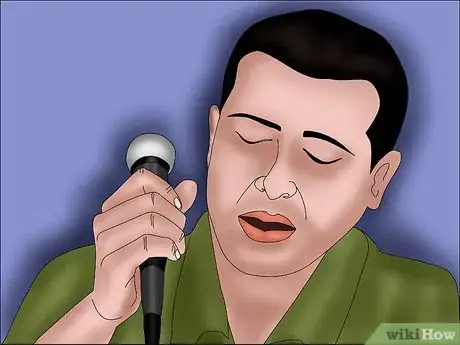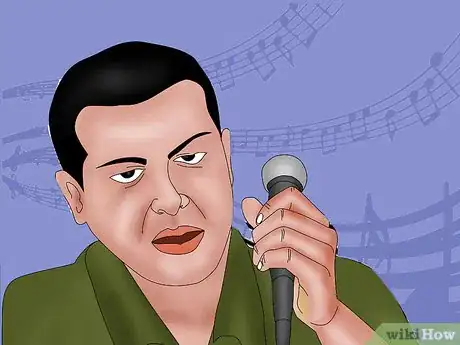wikiHow is a “wiki,” similar to Wikipedia, which means that many of our articles are co-written by multiple authors. To create this article, 108 people, some anonymous, worked to edit and improve it over time.
This article has been viewed 1,236,819 times.
Learn more...
This article is a hodgepodge of advice from different people who consider themselves screamers. Many of them probably use different techniques. The purpose of this article is to teach you how to "scream" (as many singers do these days) without hurting yourself. if you are good at inward vocals please try doing the outward screams also because it will show that you have many different kinds of metal, death metal, and grind-core skills. Also with any kind of singing you do keep in mind you're getting better every time you practice.
Screaming for musical performance is not about screaming your lungs out! While it may sound like some singers are screaming as hard and loud as they possibly can, most are not. Musical screaming is about learning to use your false vocal cords to produce screaming sounds, even though you are not screaming loudly or forcefully. If you do this, you can learn to scream as much as you want and you never have to worry about losing or damaging your voice because you scream in a band.
Steps
-
1You should know what your voice range is (baritone, tenor, contralto, mezzo soprano, etc). If you don't already know, then search for info on the different voice ranges. Find an instrument you can sing along to, such as a guitar or piano, find middle C (256 Hz), and figure out what range you fit in to.[1]
-
2Warm up. Every good metal screamer does a warm-up at some time of the day before a performance. This is not a screaming warm-up, it's a singing warm-up. People like Randy Blythe of Lamb of God, Byron Davis of God Forbid, and Phil Labonte of All That Remains, all practice conventional singing warm-up exercises before a performance; the same fundamental exercises that you would do before choir practice. This is very important for your voice so don't be lazy and skip it. Find a singing warm-up routine, like singing the vowels--Eh, Ee, Ah, Oh, Oo--over a 5-note scale.[2]Advertisement
-
3When you first start learning, you're going to be making a lot of dodgy noises. Like little cat growls and trying to speak like Marge Simpson. It's important that you create your scratchy sounds from the nasal region in the back, above your throat, not low in your throat. If you make the sound from low in your throat, you will be teaching yourself to do it wrong and learning a method that will hurt you. Try to feel the difference between the Marge voice and the low-in-the-throat, gargle-like noise. You should be able to create the Marge voice without hurting yourself. Use these two points of reference as you're learning. Remember to keep your scratchy sounds coming from higher up (the nasal region) so you don't damage your voice. If you're doing it wrong, it will hurt. Practice intelligently. You will probably be screaming wrong in the beginning, so save your voice until you figure out how to do it right.[3]
-
4Use your diaphragm correctly! Don't hold the air in your chest! You should breath in and fill your stomach, not your chest.[4]
-
5When you are first learning to scream and do not know how to use your diaphragm, flex your abdominals, kind of like you're about to take a punch. After you do that, talk a little bit, if you get a raspy sound coming out, you are talking correctly.[5]
-
6All you have to do from there, is repeatedly (over the course of many weeks), raise and lower pitch. Also after a long time of practice as to where you can get different pitches, try pushing out more air.
-
7The more air you push out, the higher in pitch your screams will be. When performing high exhale screams, open your mouth as wide as possible and scream while flexing the diaphragm.[6]
-
8It is MOST likely that it will hurt at first, but after a while you will learn how to do this correctly. If, however, it continues to hurt and/or bleeds, you are doing it wrong.
-
9To attain a different pitch use your diaphragm, tongue position and the shape of your mouth... lows for eg - lower your tongue open your mouth wide. For highs, raise your tongue high and allow the scream to hit the top of your throat.
-
10For future reference, in most of the music that you might be trying to imitate, they use distortion effects in the studio or auto tune to make a deeper and fuller pitch.
Community Q&A
-
QuestionAre there any vocal exercises I can do to make my screaming voice sound like the vocalist of my favorite band?
 Community AnswerJust listen along and try your best to mimic their tone. Experiment with tongue shape, lip positioning and similar can all help you get the effect you're looking for. Each artist has their own unique combination of these things, and a trial-and-error approach to any song by them is a good way to learn their style.
Community AnswerJust listen along and try your best to mimic their tone. Experiment with tongue shape, lip positioning and similar can all help you get the effect you're looking for. Each artist has their own unique combination of these things, and a trial-and-error approach to any song by them is a good way to learn their style. -
QuestionHow do I scream better if I'm not good at singing?
 Community AnswerYou don't have to be good at singing. The point of the vocal warm-up is so that you don't strain your vocal chords as much when you scream.
Community AnswerYou don't have to be good at singing. The point of the vocal warm-up is so that you don't strain your vocal chords as much when you scream. -
QuestionShould my throat vibrate?
 Community AnswerSort of, but as the instructions say, the sensation should be felt mostly around the back area of your nose and mouth.
Community AnswerSort of, but as the instructions say, the sensation should be felt mostly around the back area of your nose and mouth.
Warnings
- Make sure you constantly breathe, as screaming can take a lot of breath. Over time, you'll develop stronger and more powerful lungs, it is simply a beneficial side effect of this amazing art (screaming and growling).⧼thumbs_response⧽
- You may have some jaw-cramping if you are not experienced with screaming/growling. Do not continue a scream if you get a cramp! You won't be able to scream/sing/growl for weeks afterwords.⧼thumbs_response⧽
- Screaming can be overwhelming at times, so be sure to properly breathe and do NOT scream at the top of your lungs. Passing out on stage does not sound like a good idea, so remember that using as much air as possible is damaging to the vocal cords and can lead to hyperventilation, dizziness, and overexertion.⧼thumbs_response⧽
- Pushing a scream too hard may cause a short-lived headache (not more than 10 seconds). Although harmless it's debilitating enough to make you miss your next phrase. Continuing to scream through the headache period only extends it.⧼thumbs_response⧽
- Make sure your voice doesn't hurt too bad after you scream. This means that you are stressing your vocal cords too much. Loosen up and let it out. When you first begin to learn how to scream and growl, your throat will slightly "ache": this is okay, and it is natural. After a while, if you have been careful along the way, you'll be able to go for hours without hurting your throat.⧼thumbs_response⧽
- When screaming, make sure you use good diaphragm support. Exhale with your diaphragm and tense your abs. As Melissa Cross explains, you need to balance the air pressure you use with the work your false cords do so you don't put too much stress on the cords. As mentioned earlier and in several other screaming articles, do not slouch or let your body hang limp, even when not performing or practicing. An example of how to hold yourself up would be those inspiring band group photo's, the ones that show the entire metal band standing (usually) side by side. Most of these photo's depict the band members with badass or menacing frowns, and this is just a minor aspect of metal, though if you look closely at their posture, you can see them standing straight and tall. This is how you should be whenever you can help it.⧼thumbs_response⧽
- If you don't drink water your throat can feel very dry and damage your voice. But, also remember to only drink warm or room temperature water for moistening your throat. The reason for this is that when you drink cold or near-freezing water, you, in a way, "stiffen" your vocal cords, and while screaming or growling, can cause damage or pain, or both.⧼thumbs_response⧽
References
- ↑ https://www.musicnotes.com/now/tips/determine-vocal-range/
- ↑ https://www.youtube.com/watch?v=Zg6D1elBtJM
- ↑ https://www.becomesingers.com/techniques/how-to-properly-scream-sing
- ↑ https://www.youtube.com/watch?v=teihdBE3O8U
- ↑ https://www.youtube.com/watch?v=teihdBE3O8U
- ↑ https://www.backstage.com/magazine/article/ways-scream-safely-6492/



































































